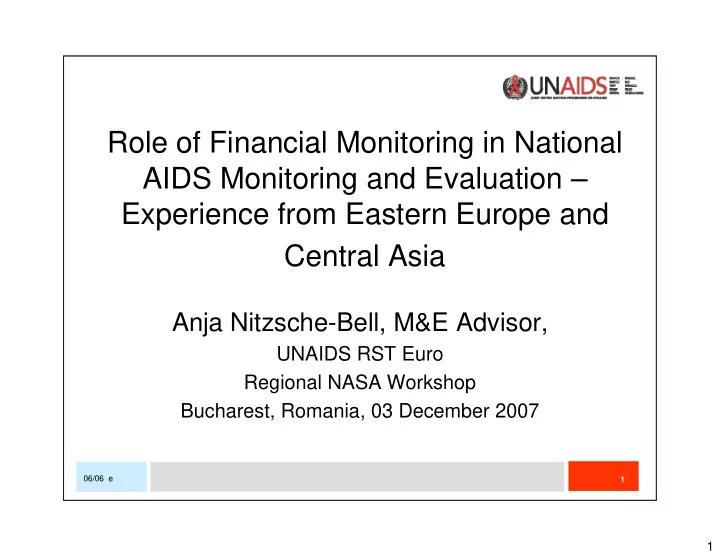

Role of Financial Monitoring in National AIDS Monitoring and Evaluation – Experience from Eastern Europe and Central Asia Anja Nitzsche-Bell, M&E Advisor, UNAIDS RST Euro Regional NASA Workshop Bucharest, Romania, 03 December 2007 06/06 e 1 1
Why HIV/AIDS M&E? “Raise it, spend it, prove it” Richard Feachem, frm. Executive Director Global Fund to Fight AIDS, TB and Malaria 06/06 e 2 2
Why M&E of HIV/AIDS? Increasing demand for effective M&E of the epidemic and the response due to: � Rapid expansion of new resources available to respond to the epidemic (GFATM, PEPFAR, WB, public funding, etc.) � Rapid scale-up of treatment and prevention programs (3x5, Universal Access) � Global push for improved coordination among donors and among donors and national HIV/AIDS programs – focus on strengthening national capacities 06/06 e 3 3
The “Three Ones” Key Principles 1. One agreed HIV and AIDS action framework 2. One national AIDS coordinating authority 3. One agreed monitoring and evaluation framework 06/06 e 4 4
Components of a National M&E System � Biological and behavioral HIV/AIDS surveillance � Essential research on HIV/AIDS prevention, treatment and care � Program activity monitoring and program evaluation � Financial monitoring, resource needs estimates 06/06 e 5 5
Financial M&E to monitor program implementation and effectiveness Allows answering questions addressing: • Spending Patterns – What are key funding sources (public, private, non-for-profit organizations, donors, etc.) – proportional spending – How does national level spending compare to spending at the sub-national level? • Cost-efficiency – How are economic inputs into HIV/AIDS programs (funds, expertise, time, etc.) converted into results? – Do we see economies of scale as service coverage goes up? • Equity – Are populations in need benefiting? 06/06 e 6 6
Financial Resource Tracking in Eastern Europe and Central Asia 06/06 e 7 7
Estimated total annual resources available for AIDS 1996 – 2005 9,000 8,297 8,000 Data includes: 7,000 •International donors, domestic spending $ US Million Signing 6,000 (including public of DOC spending and out -of- 6,079 5,000 pocket expenditures) 4,000 • International Foundations and GF 3,000 included from 2003 onwards, PEPFAR 2,000 893 1,359 included from 2004 485 479 1,000 onwards 292 1,623 1996 1997 1998 1999 2000 2001 2002 2003 2004 06/06 e 8 8
Trends in domestic and international AIDS funding, 10 CIS countries $70 Millions $60 $50 $40 $30 $20 $10 $0 2001 2002 2003 2004 2005 2006 Domestic Public Expenditures International Financing 06/06 e 9 9
Domestic public expenditures for HIV and AIDS in ten CIS States and Latvia, 2006 2006 Armenia 2% 0% Belarus 12% 1% 1% Georgia Kyrgyzstan 13% Kazakhstan 1% Latvia Moldova 7% Russian Federation 1% 61% Tajikistan 1% Uzbekistan Ukraine 06/06 e 10 10
Per capita domestic public expenditures for HIV and AIDS (CIS and Latvia, 2005-2006) Domestic Expenditures/cap 2005-2006 Armenia 0.9 Belarus 0.8 Georgia 0.7 Kazakhstan 0.6 0.5 Kyrgyz Rep. 0.4 Moldova 0.3 Russia 0.2 0.1 Tajikistan 0 Ukraine Domestic per Domestic per Uzbekistan capita05 capita06 Latvia 06/06 e 11 11
Financial Resource Tracking in Selected Countries 06/06 e 12 12
Country reporting on domestic expenditure (DoC review, March 2006) 06/06 e 13 13
Conducting NASA in the Russian Federation to assess HIV/AIDS Spending, 2004 • Government Funding: 37 million US$ • Donor Funding: 30 million US$ 06/06 e 14 14
Allocations by Functions, 2004 06/06 e 15 15
Allocation to Preventive Activities by Function, 2004 06/06 e 16 16
CONCLUSION • Low spending : Only 0.2% of the total Russian health budget was allocated to HIV/AIDS treatment and prevention in 2004. • Imbalance in spending for prevention activities: close to 50% spent on blood safety, one-fifth of the funds aimed at mother-to-child transmission and 30% was spent on mass media activities (almost zero spending on MARPs). • Insufficient funding for T&C : 23 % of public funding allocated to treatment and care (diagnostics, purchasing of test systems, ARV, OI treatment). • Major funding gap for social support and mitigation: 0.06%. No funding allocated for orphans and vulnerable children. 06/06 e 17 17
HIV/AIDS NHA Sub-analysis Ukraine, 2004 06/06 e 18 18
Sources of Health Financing for HIV/AIDS in Ukraine, 2004 06/06 e 19 19
International Comparison for Expenditures for HIV/AIDS by Functions 06/06 e 20 20
Recommend
More recommend